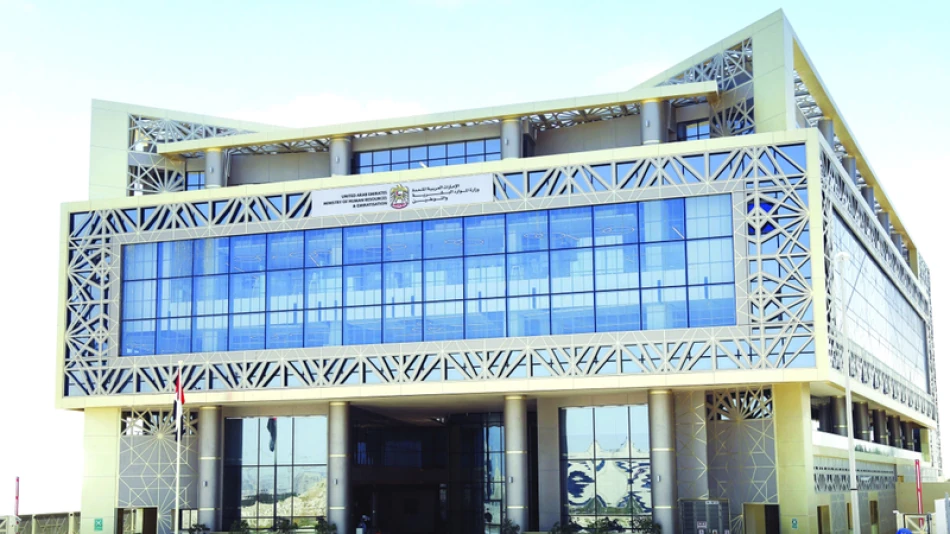
Empowering Employers: Nationalization Initiative Launches Educational Resource Kit
UAE Introduces Comprehensive Worker Leave Framework as Labor Market Competition Intensifies
The UAE's Ministry of Human Resources and Emiratisation has launched an educational initiative outlining seven distinct types of employee leave entitlements under the country's updated labor law. The move signals the Emirates' strategic push to create more attractive working conditions as it competes globally for talent while balancing employer flexibility with worker protections in an increasingly competitive regional market.
Seven-Pillar Leave Structure Reshapes Employment Standards
Under Labor Law No. 33 of 2021, private sector employees now have access to annual leave, sick leave, study leave, parental leave, bereavement leave, national service leave, and maternity leave. The comprehensive framework represents one of the region's most detailed leave structures, positioning the UAE ahead of many regional competitors in worker benefits.
The annual leave provision guarantees employees a minimum of 30 days paid vacation per year of continuous service, with proportional entitlements for shorter tenures. This standard matches or exceeds many European benchmarks, a deliberate strategy as the UAE seeks to attract international professionals who might otherwise consider Singapore or Hong Kong.
Sick Leave Balances Worker Protection with Business Needs
The sick leave policy allows up to 90 days annually after the probation period, with the first 15 days at full pay, the next 30 at half pay, and remaining days unpaid. This tiered approach reflects the UAE's attempt to prevent abuse while maintaining genuine worker protection—a challenge many countries struggle to balance effectively.
Notably, the law excludes coverage for illnesses resulting from employee misconduct, giving employers recourse against potential system gaming while maintaining the social safety net concept.
Family-Focused Policies Signal Social Evolution
The inclusion of five-day parental leave for both mothers and fathers represents a significant cultural shift in a region traditionally less focused on work-life balance. This benefit, available within six months of childbirth, can be taken consecutively or intermittently—offering flexibility that many Western countries still lack.
Bereavement leave varies by relationship proximity, with five days for spouses and three days for immediate family members including parents, children, siblings, grandparents, and grandchildren. This comprehensive family recognition reflects the UAE's understanding that a stable workforce requires emotional support structures.
Education and National Service Integration
The 10-day annual study leave for employees enrolled in accredited educational institutions, available after two years of service, directly supports the UAE's knowledge economy ambitions. This policy encourages continuous learning while ensuring employer investment protection through the tenure requirement.
UAE nationals receive paid leave for national service obligations, reinforcing civic duty while protecting career progression—a model other Gulf states may adopt as they expand mandatory service programs.
Market Implications and Regional Competition
This regulatory framework arrives as the UAE faces intensifying competition from Saudi Arabia's Vision 2030 initiatives and Qatar's post-World Cup economic diversification. By codifying generous leave policies, the Emirates is essentially raising the regional employment standards bar, potentially forcing neighboring countries to enhance their own worker benefits to retain talent.
For multinational employers, these requirements represent both compliance costs and competitive advantages. Companies can now market UAE positions as offering superior work-life balance compared to other regional hubs, potentially justifying premium salary packages through comprehensive benefits.
End-of-Service Benefits Strengthen Retention Strategy
The gratuity structure—21 days' pay per year for the first five years, then 30 days annually thereafter—creates golden handcuffs encouraging longer tenures. This approach addresses the UAE's historical challenge with high employee turnover while building a more stable, experienced workforce essential for economic diversification beyond oil.
For foreign workers, these benefits calculated on final basic salary provide meaningful financial security, potentially reducing the brain drain that affects many developing economies. The policy effectively transforms the UAE from a short-term opportunity destination into a viable long-term career base.
Implementation Challenges and Economic Impact
While progressive on paper, successful implementation will depend on enforcement mechanisms and employer adaptation. Small and medium enterprises, which form the backbone of the UAE's private sector, may struggle with the administrative burden and financial implications of comprehensive leave management.
The timing coincides with global labor shortages and rising employee expectations post-pandemic, suggesting the UAE is positioning itself advantageously for the next economic cycle. However, the real test will be whether these policies translate into measurable improvements in productivity, innovation, and economic competitiveness over the coming years.
 Sara Khaled
Sara Khaled







